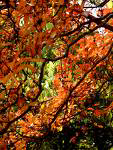CATALYTIC REACTIONS?
If you have a photo or other
graphic that reflects an aspect of life
(including laboratory life) or a
quotation that scientists might
appreciate that would be fit to print
in the space to the right, why not
send it to us via e-mail:
<catalyst@nih.gov>; fax: 402-4303; or mail: Building 2, Room 2E26.
Also,
we welcome "letters to the editor" for publication and your
reactions to anything on the Catalyst pages.
In Future Issues...
Biophotonic Imaging
IRP Research Roundup
Women's Health Fellowship
 |
Kids' Catalyst
BEFORE YOUR EYES: CHANGING COLORS
It's fall, and all around you leaves are falling and changing in a magnificent display of colors.
Even though most of the flowers are gone now, you can probably find a few for our current experiment–which will play a little trick on your eyes at the same time it sweetly illustrates how we perceive color.
For our series of colorful experiments, you will need some flowers, some sugar, an eye dropper, and red, blue, and yellow food coloring.
Experiment 1: Your supplies are a white rose or carnation and red food coloring. Put the flower in about an inch of water and add 7 to 10 drops of the food coloring. Depending on how healthy the flower is and how long the stem is, in about half an hour you will begin to see spots on the flower that are the same color as the water. So you can very easily turn that white rose to red!
Experiment 2: Now try a yellow rose and blue food coloring. If you put a yellow rose into blue water, what do you think will happen? From a distance, that flower may look green, but if you look more closely, you’ll see blue spots on a yellow background. Is this what green looks like if you peer really closely? See what happens with a "sweet" side experiment, using colored sugar.
Experiment 3: Create two piles of sugar, say a tablespoon each. Add yellow food coloring to one pile and blue to the other, adding a drop at a time and mixing thoroughly until you get the desired color (you don’t want to add too much coloring because it will dissolve the sugar). Now take equal amounts of yellow sugar and blue sugar and mix them together. (No tasting, please, unless you want to change the color of your tongue, too!) Green, right? But just like with the yellow rose, only from a distance. The closer you look, the more clearly you can see the constituent parts. Try this with other colors.
You can also test this with a nonpermanent green highlighter. Draw a line on paper (filter paper, if you have it, but loose-leaf paper and even tissue paper will work) and dip the end in water. As the water creeps up the paper, it will separate the green into other colors—yellow and blue.
So if you have a bunch of white roses you wish were red, plain sugar you wish were green, or want to see what blue can do, now you know!
|
PUBLISHER EDITORS Henry
Metzger
|
MANAGING
EDITOR COPY
EDITOR CONTRIBUTING
WRITERS |
EDITORIAL ADVISORY BOARD Jorge
Carrasquillo, CC
|